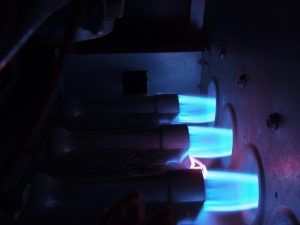Of course, even forced-air heaters vary amongst each other, on everything from price to function. We’ll help clear the air on the differences, so you can make a more informed installation or replacement when that time comes.
Furnaces
Furnaces are the most common kinds of forced-air heating systems—and for good reason. They’re easy to install, don’t cost a fortune, and they get the job done. It’s not unlikely that you own a furnace because it was already installed in your home.
Furnaces use gas burners to generate heated air, which is then blown into your home through a series of ducts. Ducts are one of the most efficient ways to get air to every room in your home, but you have to take care to have them maintained and cleaned every year. Over time, the sealant holding the ducts can wear out, leading to inefficiencies.
Heat Pumps
Heat pumps are an entire category of heaters—and air conditioners, for that matter. They’re beloved systems because they can either heat or cool the air, all with the flip of a switch, allowing them to be used year-round.
How do they work? Simply by reversing the process that makes a central AC system work! Instead of generating heat from nothing, heat pumps move warm air from one place to another. This makes them incredibly efficient heaters, which puts their monthly operational costs lower than other systems.
Traditional heat pumps
are installed similarly to furnaces or central AC systems, using ducts to transport air. On the other hand,
ductless heat pumps
consist of one outdoor unit and as many indoor units as there are bedrooms to be heated or cooled. Ductless heat pumps are even more efficient, but they do come with a heftier installation price.
Geothermal Heating
While technically heat pumps, these systems deserve their own category. While traditional and ductless heat pumps are air-sourced, meaning they transfer warmth through the air, geothermal heat pumps are ground-source. These heat pumps consist of big metal coils dug under the ground. Since underground temperatures stay stable all year, the system can efficiently pull in warm air no matter the season. Their parts are estimated to last for decades, meaning you won’t need to call for
heating repair in Portland, OR
nearly as often.
High-Velocity Heating System
High-velocity systems are the solution for older or smaller homes that aren’t equipped to have normal ducts installed in the walls or floorboards. Traditional duct systems use custom-fitted ducts to supply air to the vents of each room. Instead, high-velocity systems use small, flexible tubes that deliver air at much higher speeds. This process creates much more even heating and cooling, making them more efficient.
Looking for the perfect heater to carry you through the season? Contact The Clean Air Act today!
The post
Which Forced-Air Heater Should I Install?
first appeared on
Clean Air Act Inc.
.
Whether you require installation, repair, or maintenance, our technicians will assist you with top-quality service at any time of the day or night. Take comfort in knowing your indoor air quality is the best it can be with MOE heating & cooling services Ontario's solution for heating, air conditioning, and ventilation that’s cooler than the rest.
Contact us to schedule a visit. Our qualified team of technicians, are always ready to help you and guide you for heating and cooling issues. Weather you want to replace an old furnace or install a brand new air conditioner, we are here to help you. Our main office is at Kitchener but we can service most of Ontario's cities
Source link



